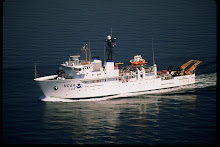
We are almost there!
We are holding station at 0 degrees 3 minutes North and 154 degrees 58 minutes West while we conduct out second deep (3000 meter) CTD.
This cast began at 9:13 AM ship time (19:13 Zulu) and made it to depth at 10:10 AM ship time. The depth is 4650 meters at this location.
This cast has significance to Rick’s students (and his Daughter) because this is the first cup cast the cruise.
Rick spent about 30 minutes making sure that the mesh bags with 172 cups (a record for a single cast on the KA) and the bag with the Styrofoam head were attached on the instrument cage securely and in a way that would not interfere with the operation of the instruments on the CTD. As you can see from these pictures the results were profound.
When Rick returns to the classroom he will return all the cups to their rightful owners. The kids will then recalculate the volume, mass, height and diameter (if they can) and determine the rate of compression for the styrofoam cups. And of course the famous shrunken head his Daughter provided.

After recovery of the CTD Rick and Art spent about a 45 minutes getting the mesh bags off the CTD, untied and for a few of the cups that had nested, carefully pulling them apart so that they would dry as individual “mini-cups”. As soon as this task was completed we moved to the TAO-CO2 Buoy that we are going to replace. The new buoy will be the Bobcat-Bronc Buoy and will be deployed tomorrow since the recovery started around 2 PM and wasn’t complete until just about dark. Tonight we will remaining on station through the night, making five mile loops around the position of the new buoy so there is a very good chance that we will cross the equator 10 or more times tonight.

As Rick wrote, today we recovered a buoy designed to measure the amount of CO2 in ocean water in addition to typical data (i.e., temperature, wind speed, humidity, rain and salinity). During the recovery I had the opportunity to ride the RHIB out to the CO2buoy to help the Chief Scientist remove some equipment before pulling the buoy onto the ship. Our ride to the buoy was phenomenal! We were told by the Coxswain to “hold on tight” to the ropes surrounding the top of the RHIB. As we pushed through the indigo waves of the ocean at

the equator, I felt like a Montana bull rider holding on for dear life. While Brian was removing the anemometer and the rain gauge, I attached a short rope with a coupling to one leg of the buoy that a larger rope could be attached and bring the buoy aboard the ship. While on the buoy, I realized that the only other thing in site for miles was our mother ship, the Ka’Imimoana!

The RHIB returned to pick us up and then went back to the ship to retrieve the rope that would be attached to the buoy. After some concern that the anchor did not release, the buoy was hauled aboard and stowed for future use. Tomorrow the new CO2 buoy will be deployed.

This morning we were at 3 minutes North (3 nautical miles) of the equator, about a half hour ago we were only 3/10th of a mile North, we are really getting close. On to the Southern Hemisphere!
Art and Rick
 We are almost there! We are holding station at 0 degrees 3 minutes North and 154 degrees 58 minutes West while we conduct out second deep (3000 meter) CTD. This cast began at 9:13 AM ship time (19:13 Zulu) and made it to depth at 10:10 AM ship time. The depth is 4650 meters at this location.
We are almost there! We are holding station at 0 degrees 3 minutes North and 154 degrees 58 minutes West while we conduct out second deep (3000 meter) CTD. This cast began at 9:13 AM ship time (19:13 Zulu) and made it to depth at 10:10 AM ship time. The depth is 4650 meters at this location. 








HAHAHAHA! The incredible shrinking head! What a kick - the kids are excited to see their cups. I'm already going nuts with school - lol. Enjoy your sea legs. Teri
ReplyDeleteHi Teri, I am glad that you like it. It really did shrink...a whole lot more than I thought it would. It really is funny because it feels really heavy, but it is the same mass as it was when it was big...talk about density. We are just about done with the 'real science' on this leg of the cruise. Now it is on to painting and other tasks that make the science possible. Dad.
ReplyDeleteHello Art and Rick I'm enjoying hearing about your adventures!
ReplyDeleteJessica Krim
Hi Jessica,
ReplyDeleteWe are glad that you are enjoying our experience. We have had a great time learning about the research that the KA is doing and what it is like to live on a ship with 30 or so others who really need to depend on each other to make the science happen. Again, thanks for following. Rick